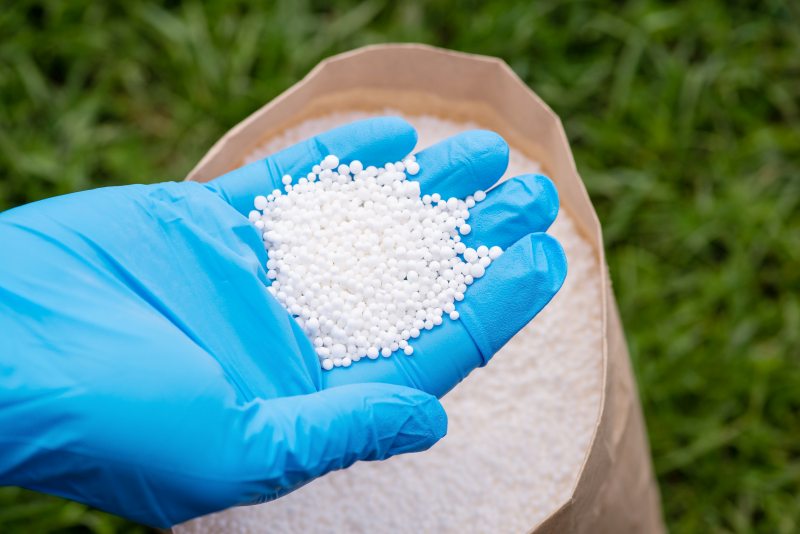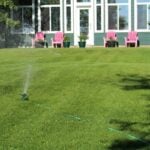
There are a few things you have to do to get your North Dakota lawn up and running in the spring, like applying weed killer, removing weeds, mowing, and watering.
Spring lawn maintenance helps your grass recover quickly from dormancy and stay healthy throughout the long growing months and well into the fall.
March Lawn Care Tips for North Dakota
Spring begins on March 20 or 21. Use this time to prep your lawn equipment and buy fertilizer for your grass. March weather is unpredictable and can sometimes dip below freezing temperatures, especially in eastern and western North Dakota. So, don’t begin mowing just yet.
Prep Your Lawn Equipment

Your mower and other lawn equipment have been idle in the garage throughout the winter. Now that spring has arrived, here’s how you can get them duty-ready:
- Gas-powered tools: Stock up on gas, replace the engine oil and oil filter, and change the spark plug.
- Electric tools: Check the batteries and replace them if they’re in poor condition.
- Weed eater: Check if it has enough string. If there’s less than half, replace the string it so you don’t have to worry about it throughout the season.
- Sharpen the blades: Check your mower and hedge trimmer and sharpen the blades if necessary.
We have a great guide on how to sharpen lawn mower blades, but here’s the short version:
- Disconnect the spark plug to prevent the motor from accidentally starting, then drain the gas tank.
- Use a long-handled wrench to remove the blade. Mark the blade with a marker to know which side faces up when installing.
- Spray WD-40 and clean the blade with a brush. If debris buildup is excessive, use a putty knife.
- Place the blade in a vice and push the file or bench grinder following the blade’s angle.
- Repeat the same on the other side. If the blade has significant wear or damage, replace it.
Pro tip: When sharpening the blade, rinse the mower deck and scrape off accumulated grass, dirt, and other debris with a putty knife for optimal performance.
Spread Snow Evenly
In March, the ground will still be covered with snow, and much of the state continues to get snowfall throughout the month. Use a rake or shovel to spread the snow evenly across your lawn.
If the snow is uneven, certain parts of the grass can wake up from dormancy early, causing diseases like snow mold. Spreading snow also helps it melt faster.
Note: Grass is fragile when it’s in dormancy. So, ensure not to step on bare spots, especially if wet.
Buy Weed Killer and Fertilizer

Early spring is the best time to apply pre-emergent herbicides because they prevent weeds from germinating. It’s important to have them ready so you can use them at the right time.
If you didn’t fertilize your lawn the previous fall, spring is the next best time. In this case, buy the fertilizer early in the season to get some good deals. See our recommendations for the best grass fertilizers.
April Lawn Care Tips for North Dakota
The weather in April gets almost 20 degrees warmer compared to March, making it the perfect time to start lawn maintenance activities.
Test Your Soil
The more you know about your soil, the better you can care for your lawn. We recommend testing your soil at least once a year and before fertilizing so you can choose the right fertilizer.
You can test the soil yourself with a DIY test kit or send it to a local soil testing laboratory for a complete analysis. Follow these steps to test the soil yourself:
- Dig holes and collect samples from at least five parts of your garden.
- Pour the samples into one large container and mix thoroughly.
- Spread the soil on paper or newsprint and let it dry for 12 hours.
- Transfer 150g of soil to a large measuring cup and mix with about 1,200mL (5 cups) of distilled water. Let the soil settle at the bottom of the container.
- Transfer the solution from the container to a chamber.
- Break the pH-testing capsule carefully and add its content to the chamber.
- Shake the chamber and let it sit for 30 minutes.
- Compare the color of the sample to the chart.
The ideal soil pH is 6.0 to 7.5. If the pH is higher (alkaline soil), treat it with elemental sulfur. If it’s lower (acidic soil), treat it with lime.
Rake

As the temperature starts warming in April, your grass wakes from deep winter sleep. Grab your rake and remove dead leaves, twigs, and other debris to allow sunlight, water, and other nutrients to reach the soil. Raking also splits grass blades to promote straight grass growth.
If you’re in Western or Eastern North Dakota, your grass is probably still wet in the first week of April. Wait till it dries so you don’t pull out healthy grass.
Thatch (a layer of dead and organic plant matter) is good for your lawn if it’s less than an inch. After your first rake, let thatch accumulate up to an inch because it protects the grass from damage and provides nutrients for growth as it decomposes.
Remove Weeds
Weeds spoil the appearance of your lawn and deprive your grass of the nutrients it needs to grow green and healthy. Apply pre-emergent herbicides in the first week of April to prevent weeds from germinating.
If the weeds have already started to germinate, it may be too late to use pre-emergent herbicides, so apply post-emergent herbicides. We recommend hand-pulling weeds if there are only a few.
Note: Pre-emergent herbicides prevent grass seeds from germinating. So, if you want to overseed your lawn after applying pre-emergent, wait at least three to four months.
Aerate (If Needed)
Aeration refers to perforating your lawn with tiny holes to allow water, air, and other nutrients to reach the soil. We recommend aerating your lawn every two years. However, you may have to aerate more often if your soil is compacted. Here are the signs of compacted soil:
- Puddling of water after rain or irrigation
- Thinning of grass or bare patches of soil where no grass can grow
- Excessive thatch
- Increased water runoff from high areas of the lawn
- Grass grows slowly
- Trees have shallow roots (ash and maple trees naturally have shallow roots)
Quick test: Pierce the ground with a screwdriver. The soil is compacted if it doesn’t budge even after applying force.
There are two ways to aerate your lawn:
- Spike aeration works well if your lawn is less than 5,000 square feet. In this type, you poke holes into the ground with spading forks. It doesn’t remove soil but pushes it deeper into the ground and towards the sides.
- Core aeration is the best way to aerate a lawn. A core aerator creates holes by removing plugs of soil from the ground. However, core aerators are expensive. Since aeration isn’t something you need to do frequently, you can rent one from your local home improvement store instead of purchasing it.
Dethatch (If Needed)

In most cases, raking helps remove thatch from your lawn. However, if a lot of thatch has accumulated, raking won’t help, and you should use a dethatcher or verticutter.
The best time to dethatch your lawn is when it’s actively growing. Cool-season grasses perform best in North Dakota, and their primary growth season is early spring. Water your yard before running the dethatcher. If you notice any bare spots after dethatching, overseed to fill them. Here’s a detailed guide on how to dethatch a lawn.
Fertilize (If Needed)
The best time to fertilize cool-season grasses is in the fall. However, if you didn’t fertilize in the previous fall, you should do so in the spring. Here’s how to fertilize your lawn:
- Test your soil if you haven’t already.
- Calculate the size of your lawn to determine how much fertilizer you need. If your yard is square or rectangular, multiply the length by width. If it’s triangular or circular, break it down into different square or rectangle sections and then add the measurements.
- The grass shouldn’t be too wet or dry when fertilizing. So, we recommend lightly watering your turf two days before fertilizing.
- Use a drop or broadcast spreader to apply fertilizer evenly. A drop spreader distributes fertilizer exactly where you want it and is ideal for smaller lawns. A broadcast spreader spreads fertilizer widely in all directions and is a better choice if your yard is over 20,000 square feet. Use a handheld fertilizer for tight spots. Check out our recommendations for the best fertilizer spreaders.
- Water your lawn to wash off fertilizer from grass blades into the soil.
Note: Avoid fertilizing your grass regularly in spring because it stimulates excess growth. While rapid growth may sound good, it’s actually bad for your turf because it doesn’t get enough nutrients and will grow weak.
Always go with slow-release fertilizers. Quick-release fertilizers promote rapid growth but can burn your grass if you don’t use them correctly. Use these fertilizers only on new lawns.
May Lawn Care Tips for North Dakota
May in North Dakota gets even warmer, and your grass will grow faster and thicker.
Mow Your Lawn
It’s May, and your grass will start growing fast, so be ready to mow. Here’s the recommended mowing height for the popular grass types in North Dakota:
| Grass Type | Recommended Mowing Height | Mow When It Reaches This Height |
| Kentucky bluegrass (cool-season) | 2.5 – 3.5 inches | 3 – 4.5 inches |
| Perennial ryegrass (cool-season) | 1.5 – 2.5 inches | 2.25 – 3.75 inches |
| Tall fescue (cool-season) | 3 – 4 inches | 2.5 – 4 inches |
| Fine fescue (cool-season) | 2.5 – 3 inches | 3.25 – 4 inches |
Here are some tips to mow your lawn:
- Choose the right lawn mower. Self-propelled mowers work well for most home lawns.
- Sharpen lawn mower blades for a perfect cut.
- Never cut over one-third of your grass in one mow.
- Leave grass clippings on your lawn.
- Vary the mowing pattern.
- Edge your lawn to make it stand out.
Water Your Lawn

Regular watering is crucial for a vibrant and healthy lawn. Most North Dakota lawns require an inch of water a week, which can be applied in two or three sessions. May is rainy in North Dakota, so be sure to account for weekly rainfall when watering your lawn.
Overwatering and underwatering are both bad for your lawn. Overwatering invites pests and diseases while underwatering makes your grass lose its color.
A simple technique to know whether your lawn needs watering is to insert a screwdriver about 3 to 4 inches into the ground. Remove the screwdriver and check for moisture. If it’s wet, your lawn doesn’t need watering.
The best time to water your lawn is in the early morning (5 a.m. to 9 a.m.). To ensure your turf gets the right amount of water at the right time, we recommend setting up an automated irrigation system.
Treat Lawn Diseases
Lawn diseases usually don’t show up until summer in North Dakota. However, fungi may form in the grass if the weather isn’t too cold. Here are some common lawn diseases in North Dakota:
- Snow mold: There are two types of snow mold — gray and pink. Gray snow mold appears as circular or irregular patches about three inches in diameter. It damages only the grass blades. Pink snow mold looks similar, except that it has a pinkish tint and is more dangerous as it damages both grass roots and blades. To treat snow mold, rake the mold and use a fungicide with azoxystrobin, bacillus subtilis, or propiconazole.
- Red thread: It appears as tan or pinkish-red circular patches about six inches in diameter. Red thread doesn’t damage your grass much, if at all. Proper lawn maintenance is the solution to this disease.
- Dollar spot: Dollar spot appears as brownish irregular circular patches about the size of a dollar coin. It shows up as cottony white growth on top of the grass in the morning. Use fungicides with PCNB, myclobutanil, propiconazole, or thiophanate-methyl to treat dollar spot.
- Fairy ring: It contains a circle of mushrooms, ranging from a few inches to a few feet in height. To eliminate this disease, dig the affected area and reseed. Regular mowing, watering, and fertilization help prevent fairy rings.
Prevention is better than cure. Here’s how you can prevent lawn diseases:
- Plant cool-season grasses because they suit North Dakota’s climate better and are more resistant to diseases.
- Avoid overwatering your grass.
- Ensure proper drainage.
- Mow your grass at the right height.
- Feed your turf with the right nutrients.
Eliminate Pests
Proper lawn maintenance can help prevent pests to a great extent, but you can’t avoid them altogether. Pests usually reproduce during spring. Act fast and eliminate these pesky creatures before they get time to lay and fertilize eggs. Here are some pests to look out for in North Dakota:
- Ants
- Billbugs
- Grubs
- Sod webworms
- Ticks
- Aphids
- Armyworms
Identify the pests in your lawn and use pesticides that target them specifically. Avoid catch-all pesticides because they are less effective and can harm beneficial insects, pets, plants, and even your kids.
Pesticides are effective, but we recommend using Integrated Pest Management (IPM) for your lawn to keep pests away for good. IPM is a long-term strategy of removing a pest’s food sources and strengthening grass to make it less susceptible to pests.
Note: If you find pests that harm humans, such as spiders, wasps, or centipedes, it’s best to hire a pro to eliminate them.
FAQs
What are the best grasses for North Dakota?
Cool-season grasses perform best in North Dakota’s warm summers and cold winters. Here are the best grasses for the state:
- Kentucky bluegrass
- Perennial ryegrass
- Tall fescue
- Fine fescue
Can I mow and fertilize on the same day?
Yes, but we recommend mowing at least three days before fertilizing so it’s easier to apply the fertilizer and the nutrients absorb better.
How can I keep my North Dakota lawn healthy in the fall?
Fall is the best time to fertilize cool-season grasses. If your turf is thinning or there are bare spots, early fall is the best time to overseed. Here are fall lawn care tips for North Dakota.
When to Hire a Professional
From Scandinavian Heritage Park to Icelandic State Park to the Roosevelt Zoo, North Dakota is home to many beautiful places. With so much to see, it’s understandable that you’re tempted to spend your weekends exploring the state with your family. Let LawnStarter North Dakota pros take care of your lawn while you’re outside having fun.
Main Image Credit: Stomner House / SH5544 / Wikimedia Commons / CC BY-SA 4.0
*LawnStarter participates in the Amazon Services LLC Associates Program, an affiliate advertising program. LawnStarter may earn revenue from products promoted in this article.





